This post contains affiliate links.
Welcome to the buzzing world of beekeeping! If you’re looking to start your very own hive, equipping yourself with the right tools and gear is essential for a successful and enjoyable beekeeping experience.
Whether you’re a budding apiarist or simply curious about this fascinating hobby, my guide will help you navigate through the essentials of beekeeping equipment. So, let’s gear up, don your bee suit, and dive into the world where the hum of bees is the sound of nature’s hardworking little marvels!
Getting Started with Beekeeping: Essential Supplies and Equipment for the Hive
Starting your beekeeping journey is an exhilarating experience, but having the essential equipment is crucial for your success. The hive, the heart of your beekeeping endeavors, requires careful attention and the right tools to thrive.
When you’re ready to start, knowing which beekeeping equipment to invest in can make all the difference. Before you dive into the world of beekeeping, assemble the basic equipment to ensure you and your bees are well-equipped for the adventure ahead.
Your beekeeping equipment plays a pivotal role in hive management, health inspections, honey extraction, and overall maintenance. As a beginner, acquiring the essential equipment may seem daunting, but it’s all part of starting your beekeeping hobby off on the right foot.
A high-quality hive is the cornerstone of any beekeeping setup, providing a safe and comfortable home for your colony. Alongside the hive, tools like smokers, hive tools, and protective gear are indispensable in the day-to-day handling of your buzzing apiary.
Every piece of beekeeping equipment serves a purpose, from ensuring your safety to helping manage the hive effectively. Don’t forget a bee suit, gloves, and a veil; these are non-negotiables for protecting yourself from stings while inspecting or working on your hive. It’s not just about the hive; it’s about the whole experience and the gear that supports it.
Investing in quality beekeeping equipment can increase the productivity of your hive and ensure a rewarding beekeeping journey. Whether you’re inspecting frames, harvesting honey, or just checking on the well-being of your colony, the right tools will make these tasks more efficient and enjoyable.
Remember, starting out with the essential equipment is your stepping stone to becoming a confident and successful beekeeper. Embrace the learning curve, as every hive is unique, and revel in the joy of tending to these remarkable creatures.
Beekeeping equipment does not need to be overly expensive or complicated, but it does need to be effective and reliable. As you mark the beginning of your beekeeping experience, let the excitement of starting your first hive motivate you to gather all the necessary tools.
Equip your beekeeping arsenal with all the necessary items to start, care, and grow your hive into a thriving bee community. And by all means, share your passion with others; there’s nothing quite like the hive-minded camaraderie among beekeeping enthusiasts!
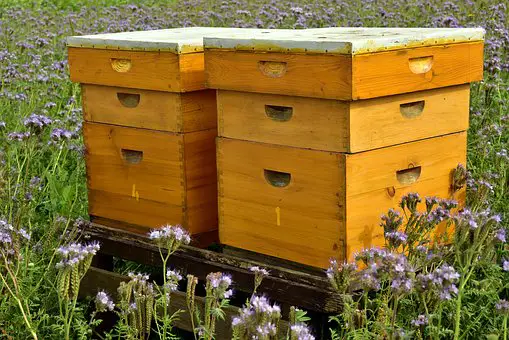
The Grandfather of Beekeeping Hives.
A Description Of The Different
Types Of Bee Hives
- Langstroth Hive: Considered the standard in beekeeping, this hive features movable frames that make it easier to manage and inspect the beehive without harming the bees. Its modular design allows for easy expansion and extraction of honey.
- Top-Bar Hive: Ideal for natural beekeepers, the top-bar hive has a horizontal layout that mimics how bees build in nature. It requires less heavy lifting and can be more accessible for people with mobility issues.
- Warre Hive: Known as the “people’s hive,” the Warre hive aims to replicate the bees’ natural environment. It’s a vertical top-bar hive that is designed to be low-maintenance and may promote bee health through its naturalistic design.
- Flow Hive: A modern innovation, the Flow Hive allows for honey to be harvested directly from the hive without opening it or disturbing the bees. It’s convenient for beekeepers because it simplifies the extraction process.
- National Hive: Popular in the UK, this hive type is similar to the Langstroth but has slightly different dimensions. It’s a good choice due to its adaptability to different climates and the ease of finding replacement parts.
- Dadant Hive: Larger than the Langstroth, the Dadant hive has deeper frames, which makes it suitable for high honey production. Its design is particularly favored by commercial beekeepers.
- British Modified National Hive: An adaptation of the National Hive, it has a larger brood area that can support a bigger bee colony. This hive type is practical for beekeepers looking to maximize their hive’s potential.
- Skep Hive: Although largely historical and not recommended for modern beekeeping, the skep is a coiled straw basket without frames. It’s more of a novelty or educational tool, as it doesn’t allow for inspection or management and is illegal in many areas because of this.
- Cathedral Hive: A vertical hive with an artistic design resembling a cathedral’s stained-glass window. This hive is intended to create a harmonious environment for bees based on sacred geometry and may appeal to beekeepers with an interest in alternative, aesthetic hive designs.
- KTBH (Kenyan Top-Bar Hive): An evolution of the traditional top-bar design, this hive slants at the sides which may offer better comb attachment and easier honey harvesting without the need for heavy lifting.
Related Articles:
- The Beginner’s Guide to Backyard Beekeeping: A Beginners Guide & Tips for the Aspiring Backyard Beekeeper
- Why Beekeeping is Important for the Environment: Essential Benefits of Bees to Biodiversity
- 5 Essential Benefits of Starting Beekeeping: Best Reason to Start Backyard Beekeeping for Beekeepers
- How to Tell If Beekeeping Is Right for You: Signs You’re a Good Beekeeper
- The History of Beekeeping: A Fascinating Journey for Bees and Beekeepers
- Understanding the Role of Bees in Our Ecosystem: Importance of Bees in the Environment
- Common Myths About Beekeeping Debunked: Beekeepers Expose Misconceptions & Bee Myths
- Understanding Bee Behavior: What New Beekeepers Must Know – Learn Honeybees and Beekeeping
Bee Suit: The First Step to Start Beekeeping Safely
Embarking on the adventure that is beginner beekeeping, you’ll soon find that the cornerstone of your beekeeping starter kit is, without a doubt, the bee suit. This remarkable piece of apparel isn’t just another item, it’s your armor and comfort when you’re in the thick of tens of thousands of buzzing bees.
Every bee suit has a single mission: to keep you safe while you dive into the wondrous world of starting your beekeeping journey. For beginner beekeepers, this suit is crucial; it allows you to start exploring the intricate behaviors of bees without the looming threat of stings.
Read my article: Why are beekeeping suits white?
Now, you may feel a buzz of excitement to start, but take a moment to appreciate how a bee suit serves as your personal hive-side companion. From the veil that protects your face and neck to the elastic cuffs that seal your wrists, a bee suit is meticulously designed to offer full coverage. It’s designed with the understanding that to start beekeeping, you need to feel confident and protected, and there’s nothing like suiting up to make you feel like a bona fide bee whisperer.
Beginning beekeeping can feel like venturing into uncharted territory, which is why selecting the right bee suit is essential. Remember, it’s not just about stings; it’s about comfort too. When you’re starting your beekeeping practice, you’ll appreciate a suit that’s breathable on those warm days spent inspecting the hive. Easy zippers and durable material are features that turn a good bee suit into a great one, enabling you to start and finish your beekeeping tasks with ease and assurance.
Imagine, donned in your bee suit, you approach the hive; the gentle hum of the bees fills the air. You’re about to start an interaction that’s been part of human culture for thousands of years. It’s moments like this when you’ll be grateful for the investment you’ve made in a high-quality bee suit.
So, as I delve further into beginner beekeeping, remember that to start off on the right foot, investing in a bee suit isn’t just recommended, it’s fundamental to your beekeeping adventure.
Whether you’re a budding environmentalist or simply fascinated by bees, a bee suit is the first step to start your foray into beekeeping with the respect and preparation that these extraordinary pollinators deserve.
And who knows? Perhaps once you’ve donned your bee suit for the first time, you’ll feel that connection to start a lifelong passion for beekeeping. After all, it’s all about starting with that first, confident step into the apiary clad in your trusty bee suit, and from there, the hives are your oyster!
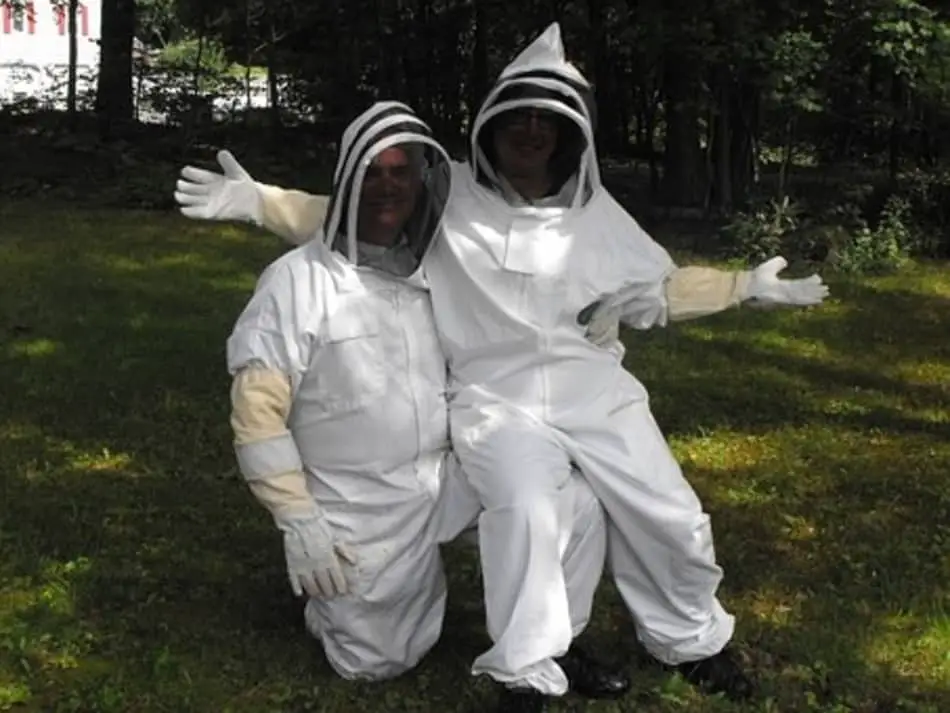
Setting Up Your Beehive: Tools and Equipment Necessary to Start
Embarking on the journey of beekeeping can be as exhilarating as it is rewarding, but before you can savour the sweetness of your labor, it’s important to gear up with the basic equipment for your hive. Becoming familiar with the necessary tools is a crucial step in ensuring that your bees thrive and you enjoy a safe beekeeping experience.
There’s a variety of gear that is deemed important for both the welfare of the bees and the keeper. Suitable equipment for your hive can be easily accessible, and getting a good start is all about understanding what’s essential.
Firstly, selecting a beehive is your foundational task. The beehive serves as the cornerstone for your hives’ success, and you’ll find there are several types, such as the Langstroth or Top-Bar models. Each of these hives has its own unique set of requirements, so pick what best suits your beekeeping style. Alongside the hive, you’ll need a hive stand to keep it off the ground, ensuring it stays dry and deters pests.
Getting into the hive will require some important tools; a smoker and hive tool are indispensable. The smoker calms your bees, making it safer to inspect your hive. The hive tool is a real workhorse, aiding you in prying apart sticky frames and scraping off excess comb and propolis.
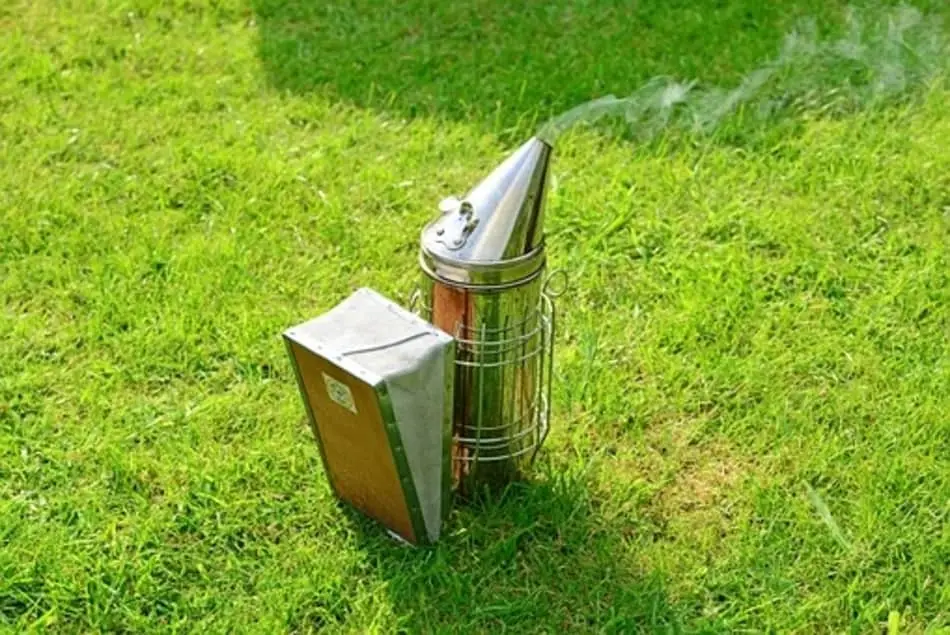
Your gear collection wouldn’t be complete without a quality bee suit for protection, gloves to shield your hands, and a veil to keep bees away from your face. It’s important to ensure that this equipment fits properly for maximum safety.
Read my article: What beekeeping gloves should I use?
When it’s time to extract honey, having the right equipment is equally important. An extractor will become a pivotal piece of gear to separate honey from the comb without destroying the bees’ hard work. Additionally, a decapping knife or fork is necessary to unseal the filled honeycomb before extraction. And let’s not forget about the various a jars and containers you’ll need to store the harvested honey!
Maintaining your hive’s health is a continued commitment, and with the right equipment, you’re well on your way to a rewarding beekeeping journey. Remember, the hive is not just a wooden structure; it’s a living, breathing ecosystem that relies on your diligence and the gear you acquire to keep it buzzing with life.
So go ahead, choose your equipment wisely, and enjoy the buzzing beauty of keeping a hive!
A List Of Essential Clothing Gear
A New Beekeeper Should Have
- Full Beekeeping Suits: Offers head-to-toe protection, which is ideal for beginners or when dealing with aggressive bees. It usually includes a built-in veil and can come in ventilated options for hot climates.
- Why to consider: Provides the most coverage and protection, reducing the risk of stings.
- Jacket and Veil Combos: These are jackets that come with an attached veil. They cover the upper body and are generally cooler to wear than full suits.
- Why to consider: Offers a balance between protection and comfort; suitable for quick inspections or moderate climates.
- Ventilated Beekeeping Suits: Designed with layers of mesh fabric to improve air circulation, which keeps the beekeeper cooler in hot weather.
- Why to consider: Essential for beekeeping in hot climates to prevent overheating.
- Beekeeping Veils: Protects the face and neck and can be worn with a hat or attached to a helmet. There are several styles including fencing, round, and square veils.
- Why to consider: Customizable with different headwear, and a good option when full body protection isn’t necessary.
- Beekeeper Gloves: They can be made of leather, cotton, or synthetic materials and are essential to protect hands and arms from stings.
- Why to consider: Gloves are crucial for protecting your hands, a common target for bees. The choice of material affects dexterity and sting resistance.
- Ventilated Gloves: Similar to ventilated suits, these gloves offer breathability and are particularly useful in warm weather to keep hands cool.
- Why to consider: They provide comfort and protection in hot temperatures.
- Goat/Lamb Leather Gloves: Offer excellent protection and more dexterity than cowhide gloves. They are soft and pliable, making it easier to handle equipment and bees.
- Why to consider: They strike a good balance between toughness and flexibility.
- Cowhide Gloves: These are the most durable and offer high levels of protection against stings but can be less flexible.
- Why to consider: Ideal for maximum protection, especially for those who are highly concerned about bee stings.
- Disposable Gloves: Made of nitrile or latex, these gloves can be used when a beekeeper needs better dexterity or wishes to ensure hygiene between hives.
- Why to consider: Useful for delicate tasks where greater finger sensitivity is required, and they provide an easy clean-up option.
From Frames to Feeders: Building the Beehive for Your Bees
As you start your beekeeping journey, understanding the importance of each component that makes up a beehive is crucial for the prosperity of the bees live. At the heart of your hive, you’ll find the hive body, also known as the brood box, section, which comprises the majority of living space for your buzzing companions.
It’s here in the brood box that the magic happens: the hive’s workers busily build comb, raise brood, and care for the queen. Constructing a hive requires attention to detail; missing out on essential tools and equipment can make or break your beekeeping success.
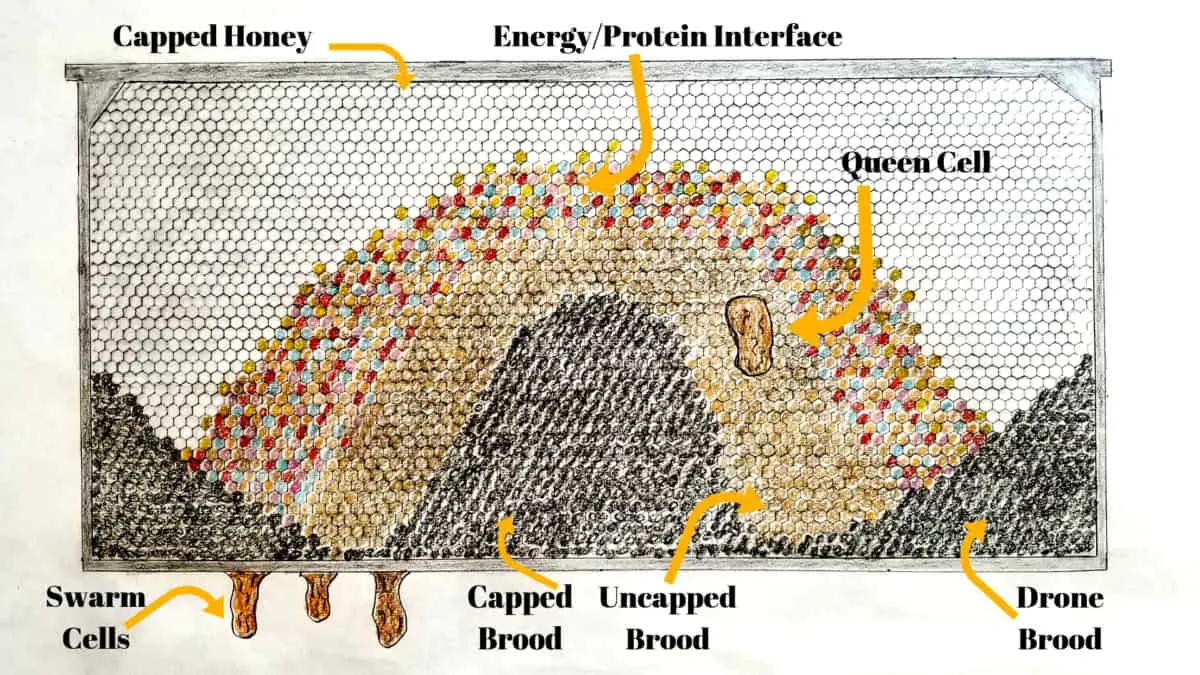
This representative frame shows good hive health,
but note the swam cells indicating overcrowding
and the potential for this hive to swarm.
Read my article: Why do bees swarm
Now, let’s consider the honey supers – these are not just additional hive components; they’re the chambers where your industrious bees will store their golden nectar. They’re stackable atop the hive body, allowing the hive to expand and produce more honey. For the beginner, knowing the difference between the various hive components and when it’s time to add that extra super is part of your beekeeping evolution.
Read my article: Adding Honey Beehive Supers: (When and Where)
Surely, you also realize the importance of frames. Serving as the skeleton within your hive, frames are where bees build out their comb. They are the foundation upon your bees create their wondrous honeycomb, and providing top-notch frames is essential to support their hard work.
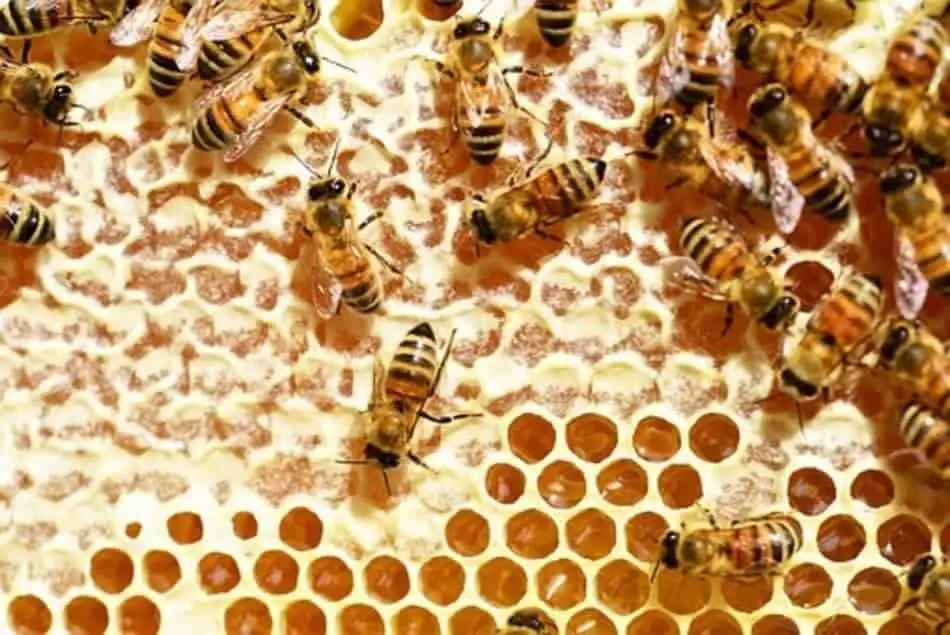
Ready for harvest when all cells are capped!
Beekeeping isn’t only about a hive, though. To start your apiary on the right foot, your gear must also include feeders, essential tools during certain times of the year when nectar is scarce and your bees need a helping hand. Your commitment to keeping those little pollinators thriving is mirrored in the quality and readiness of your beekeeping equipment.
While the hive is where your bees live, it’s the gear like smokers, hive tools, and protective clothing that enables your interactions with your hive to be smooth and safe. Starting your beekeeping without the right gear isn’t advisable; imagine trying to inspect your bees without a bee suit or pry apart frames without a proper hive tool.
Building a beehive is like assembling a puzzle, each piece essential to the whole picture. From the ground up, ensure that your beehive, your work, reflects your dedication.
Remember, every tool and every piece of gear, from the bottom board to the top cover, plays a critical role in establishing your hive. Proper maintenance and inspection utilizing your tools will become a rhythm, the dance of beekeeping that you’ll grow to love.
Your bees’ lives hinge on the quality of the hive they call home, and the more you understand and respect that, the more enjoyable your beekeeping experience will be. So, gear up, stay curious, and embrace the fulfilling journey of watching your hive thrive. Your bees, and perhaps someday your honey supers, will thank you for it.
Components Of A Beehive
- Hive Bodies/Supers:
- Deep Hive Bodies: Typically used for the brood chamber.
- Medium/Standard Hive Bodies: Can be used for both brood and honey storage.
- Shallow Hive Bodies: Mainly used for honey storage due to lighter weight when full.
- Considerations: The number of hive bodies required will depend on the size of the colony and your management preferences. Larger hives can hold more bees but are heavier to lift.
- Frames and Foundation:
- Wooden Frames with wax foundation: Traditional choice, offering stability and natural wax for bees to draw comb from.
- Plastic Frames with plastic foundation: Durable and re-usable, often coated with bee wax for better acceptance by bees.
- Considerations: The type of frame and foundation used can affect the ease of comb drawing by bees and how easy the frames are to inspect and manipulate.
- Bottom Boards:
- Solid Bottom Boards: Provides a solid floor to the hive, offering protection from the elements.
- Screened Bottom Boards: Offers ventilation and can help with varroa mite control.
- Considerations: Climate and pest management strategies will influence the choice between solid and screened bottom boards. Screened versions are better for warmer climates and integrated pest management.
- Covers:
- Inner Cover: Provides insulation and proper bee space between the top super and the outer cover.
- Telescoping Outer Cover: Overhangs the hive to provide protection from the elements.
- Migratory Outer Cover: Sits flush with the hive edges, designed for easy transportation of hives.
- Considerations: Your choice of cover will depend on whether you need to move your hives frequently (migratory) and the amount of protection from weather you want to provide.
- Queen Excluders:
- Metal Queen Excluders: Durable and long-lasting.
- Plastic Queen Excluders: Lightweight and less expensive.
- Considerations: Decide whether you want to prevent the queen from laying eggs in honey storage areas. Material choice can depend on budget and personal preference.
- Read my article: Should I use a Queen excluder
- Feeders:
- Frame Feeders: Fit within the hive like a frame; safer for bees as it’s inside the hive.
- Top Feeders: Sits on top of the hive bodies, holding a large amount of feed.
- Entrance Feeders: Attach to the hive entrance, easy to monitor and refill.
- Considerations: Feeder type will depend on the climate, the size of the hive, and how often you are able to check on and refill the feeders.
- Hive Stand:
- Standard Hive Stand: Raises the hive off the ground to deter pests and improve accessibility.
- Garden Hive Stand: Often decorative, it can also include additional features like planters or storage.
- Considerations: Hive stands can improve durability by keeping hives dry and well-ventilated. They can also reduce back strain during hive inspections.
Protective Gear for Beginner Beekeepers: Ensuring You’re Ready for the Hive
Embarking on your beekeeping journey is exciting, but it’s vitally important to make sure that you’re outfitted with the proper protective gear to ensure a safe and enjoyable experience. A quality bee suit is your first line of defense against stings and should be at the top of your beginner beekeeping equipment list. Bee suits come with veils to protect your face and keep you calm, after all, maintaining your cool is key when you’re tending to your hives.
For those just starting their beekeeping starter adventure, understanding the necessity of comprehensive beekeeping equipment can’t be overstated. Beekeeping, at its core, requires a commitment to safety for both the keeper and the bees.
Without a doubt, having your own protective gear is not just a recommendation; it’s essential when you’re working around bees. The gear you select, from your gloves to your boots, must be durable and comfortable for those long days among your buzzing companions.
As a guide to ensuring you’re fully equipped, consider every piece of gear to be a part of your armor. While a bee suit is designed to provide full coverage, additional protective gear like gloves and a veil are items you can’t afford to overlook. Ventilated suits can also offer a breezier feel for those warmer days in the field, allowing you to concentrate on what’s important, caring for your bees.
As beginner beekeepers, it’s also crucial to learn about the other pieces of equipment that are part of managing your hives. From the tools that help you handle frames to the feeders that keep your bees nourished, each item in your beekeeping arsenal supports your hive’s health and productivity. Gearing up is not just about your safety; it’s about being prepared to give your bees the best possible care.
Starting your beekeeping journey is an adventure that requires dedication and the right gear. By equipping yourself with the right beekeeping equipment, you’re taking an important step toward success. Remember, when you’re comfortably protected, you’ll find that working with your bees is more than a hobby, it’s a harmonious partnership.
Hive Management Tools: Essential Beekeeping Supplies to Maintain Your Bee Colonies
Embarking on the beekeeping adventure is one of the most exciting endeavors you’ll ever experience. As you prepare your hives, it’s essential to have the right equipment on hand.
Beekeeping equipment is not just about protection; it’s about giving you and your bees the best start possible. To manage your hives effectively, there’s a suite of essential tools that are part of every beekeeping starter kit. The beehive is the centerpiece of your beekeeping activities, and the proper hive tools are indispensable for keeping everything running smoothly.
In your arsenal of tools, the classic hive tool is the unsung hero, a truly essential tool that will aid in prying apart frames, scraping propolis, and other necessary hive manipulations. You’ll find that this tool becomes an extension of your hand as you inspect your hives.
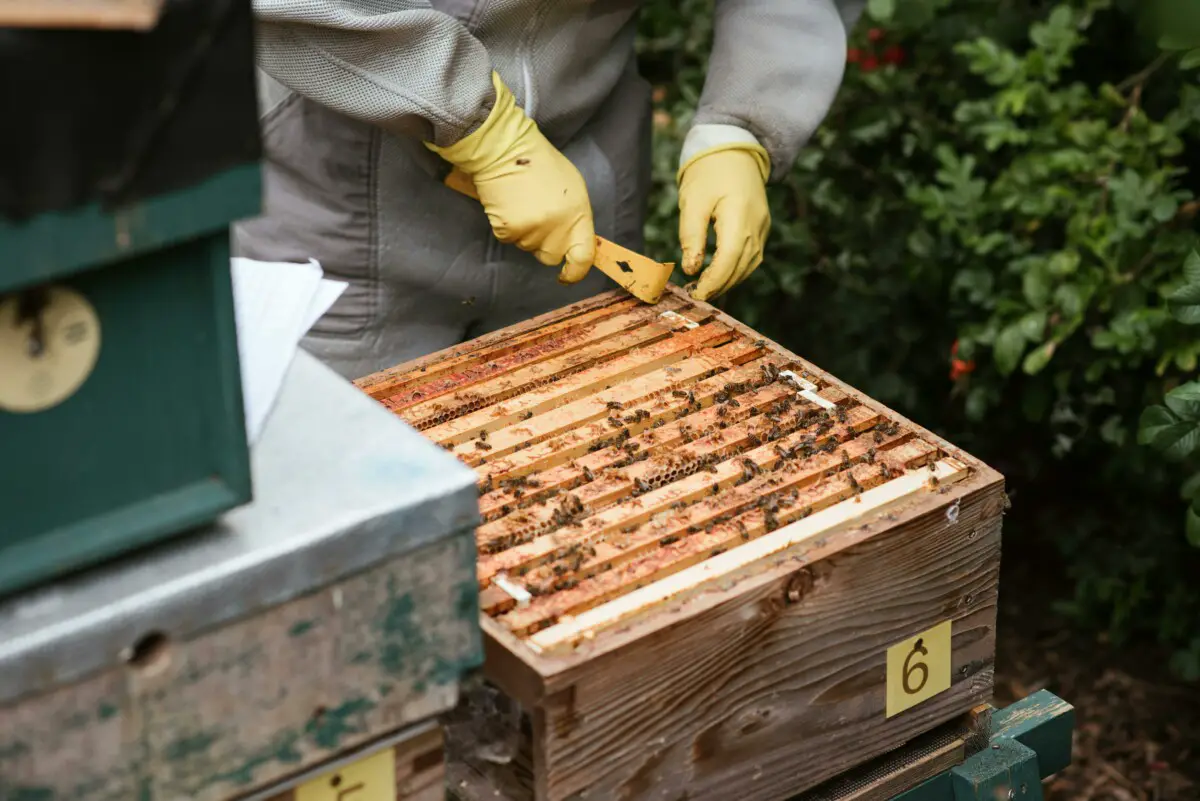
Bees glue frames into the hive with propolis.
Read my article: Propolis: The Honey Bee’s Health Prophylactic
Speaking of frames, you’ll want to use your hive tools carefully as you navigate through the frames that house your hives’ precious brood and honey stores. Bees are remarkably industrious, and they’ll amass resources rapidly, especially when your hive management practices are top-notch.
For the beekeeper, maintaining the beehive isn’t just a pastime; it’s a passion. Each hive tool, from brushes to uncapping forks, plays a vital role in the health and productivity of your bees. Your hive’s success depends on diligent use of these tools, ensuring that your hives thrive.
Moving and lifting heavy frames teeming with bees require confidence and the right equipment, your hive tool caters to these needs perfectly.
Even with the proper hive management tools, you must remember to protect yourself. Bee suits are essential beekeeping equipment that shield you from stings as you tend to your hives. Donning your suit, veil, and gloves, you’ll feel safe as you immerse yourself in the world of beekeeping. Bee suits are the first step to start your beekeeping journey safely, allowing you to focus on caring for your bees without the distraction of potential stings.
Setting up your beehive with the right tools and equipment is necessary to start your beekeeping experience, and as your skills grow, so too will your hives. From frames to feeders and beyond, building the beehive for your bees is a process that’s both rewarding and intimate.
Protective gear for beginner beekeepers is critical, ensuring you’re ready to face the hive and the thousands of bees you’ll be nurturing. Remember, the essential equipment you invest in today will serve both you and your bees for many seasons to come.
Here Is A List Of Items
A New Beekeeper Needs
- Bee Suit/Clothing: Essential for personal protection, it prevents bees from stinging.
- Gloves: Beekeeping gloves offer hand protection while handling bees and frames.
- Bee Hive Tool: A versatile tool used for prying apart hive bodies and frames, scraping wax, and cutting propolis.
- Smoker: Calms bees by masking alarm pheromones, making hive inspections safer and easier.
- Bee Brush: Gently removes bees from comb without harming them during inspections or honey harvesting.
- Uncapping Fork/Tool: Useful for uncapping honey cells so you can extract honey without damaging the frames.
- Honey Extractor: Centrifugal force is used to remove honey from the combs while preserving the comb structure for reuse.
- Hive Frames and Foundation: Provides bees with a starting point for building comb, essential for brood rearing and honey storage.
- Feeder: Supplies supplemental feed to the bees during times of nectar scarcity, promoting colony health and growth.
- Queen Excluder: Placed between the brood boxes and honey supers, it keeps the queen from laying eggs in honey storage areas.
- Beekeeping Journal: Tracking hive inspections and observations can help manage the health and productivity of the hive.
- Queen Marking Pen: Marking the queen helps you track her in the hive and during inspections; it also aids in identifying her age.
- Entrance Reducer: Helpful in defending the hive against pests and during colder months by reducing the entrance size.
- Hive Stand: Elevates the hive off the ground, reducing moisture problems and deterring pests.
- Bee Colony: The core of beekeeping; consider selecting a colony that is known for gentleness and good honey production.
- Books/Guides: Comprehensive information about bee biology, behavior, disease management, and hive maintenance.
- Varroa Mite Treatment: Keeping mite populations in check is crucial for colony health; there are various treatments available.
- Hive Tool Holder: Holds tools during hive inspections, keeping them easily accessible and clean.
- Pollen Trap: Collects pollen as bees enter the hive, which may be used as a protein source for bees or for human consumption.
- Propolis Trap: Installation of a trap can harvest propolis, a valuable hive product used in health and skin care products.
Harvesting Honey: The Equipment You Need to Extract Honey from the Beehive
As a budding apiarist, the moment will come when it’s time to reap the rewards of your dedication: the honey harvest. The air buzzes with excitement, and so do the bees, as you prepare for harvesting honey. It’s the sweet culmination of your bees’ hard work and your attentive hive care. But before you can savor the golden nectar, you’ll need the right tools to extract honey from the beehive.
To begin, you’ll want a clear plan for removing the frames from the hive. Smokers, crucial in calming the bees, allow you to work more efficiently and safely. As you lift each frame, test its weight; a heavy frame is often loaded with honey.
However, before you can harvest, ensure it’s the right time. Timing is everything, the hive must have ample honey stores, with most of the honey cells capped, indicating your bees’ hard labor is ripe for extraction.
Once you’ve selected the appropriate frames, a bee brush comes in handy to gently remove any clinging bees, ensuring that they remain at the hive as the honey begins its journey.
A honey extractor is your next pivotal purchase, using centrifugal force to fling honey from the comb while keeping the intricate structure intact, ready for the bees to refill. This rite of passage from honeycomb to jar is magical, as is watching the honey flow through a double sieve for straining, leaving behind pure, unadulterated honey.
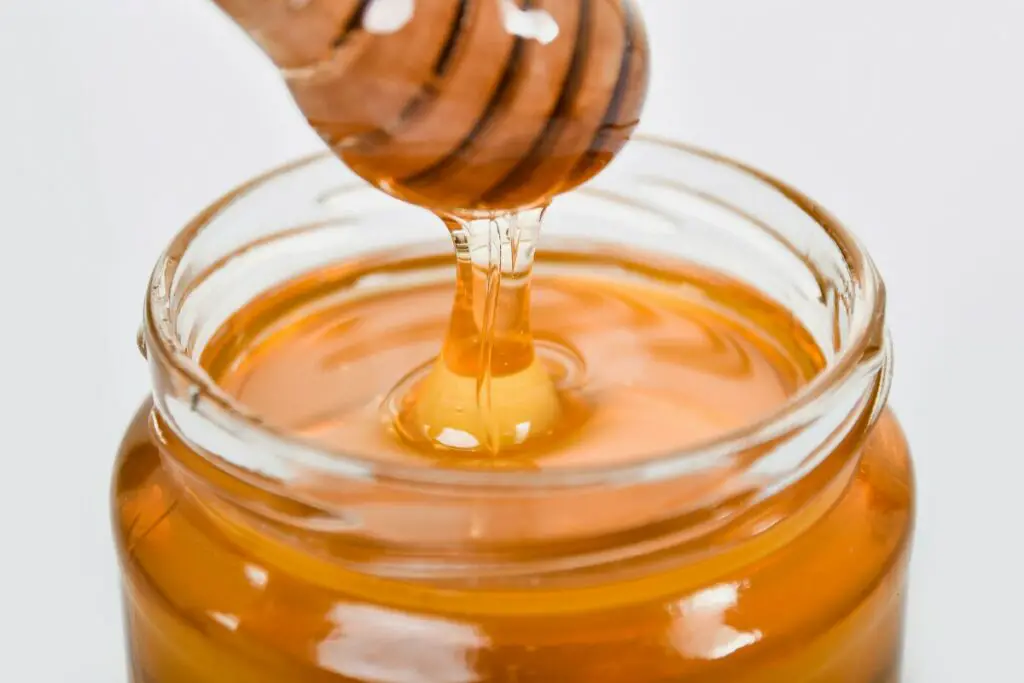
The setup can seem daunting, but it’s well worth it for the shimmering jars of honey. Uncapping knives or even a hot uncapping fork melt through the wax seal, a step necessary to access the honey. Uncapping is a craft in its own right, one that smells of beeswax and promise. Once the frames are uncapped, they’re placed in the honey extractor, the centrifuge spins, and the honey harvest begins in earnest.
Tapping the rich, amber fluid into a bucket with a gate is a sight to behold; the air fills with the scent of a thousand flowers. Finally, bottling the honey, whether using simple jars or specialized honey containers, marks the endpoint of a beekeeper’s journey from novice to seasoned hive master. The beehive, a bustling city of bees, has offered up this gift, and with the right tools, the harvest is yours to claim.
Remember, whether it’s your first honey harvest or your hundredth, the right equipment, from the hive to the honey jar, is essential. Each tool, from the bee suit to the extractor, plays a part in this intricate dance between beekeeper and bees.
Honor your bees’ industrious nature and their unyielding commitment to the hive by equipping yourself wisely and harvesting honey with the care it deserves.
For more information on beekeeping, see my other articles on beekeeping.
Frequently Asked Questions
Q: What are the essential pieces of equipment I need to start beekeeping?
A: To start your beekeeping journey, you will need a bee suit with a veil for protection, gloves for handling frames, a smoker to calm the bees during inspections, a hive tool for prying apart frames and scraping propolis, and a beehive with frames to house your colony. Additional helpful items can include a hive stand, a honey extractor, and various jars and containers for honey storage.
Q: Does the type of beehive I choose matter for a beginner?
A: Absolutely! The type of beehive you select, such as a Langstroth or Top-Bar hive, is important as each has its own set of requirements and characteristics. It’s crucial to pick one that best suits your beekeeping style and start-up goals. Make sure to research and understand the different types of hives before making your choice.
Q: How does protective gear like a bee suit improve my beekeeping experience?
A: A bee suit is designed to provide full-body coverage and protect you from bee stings, allowing you to confidently manage and inspect your hive without distraction. Gloves and a veil are also essential; ventilated suits can offer added comfort on warm days. Protective gear ensures your safety and helps maintain a calm environment for the bees, which is pivotal for effective hive management.
Q: When is the best time to harvest honey from my beehive, and what tools will I need?
A: The best time to harvest honey is when you notice most of the honey cells are capped, indicating the honey is mature. You’ll need a honey extractor, a double sieve for straining, a bee brush to gently remove any bees from the frames, and uncapping tools such as a knife or fork to access the honey. Ensure your bees have enough remaining honey for themselves before you extract.
Q: How do I maintain my hive’s health, and what equipment is necessary for this?
A: Maintaining your hive’s health involves regular inspections, providing supplementary feed when natural nectar sources are scarce, controlling pests and diseases, and ensuring the hive has enough space to grow. You’ll need a smoker, hive tool, feeders, and possibly medications for pest and disease control. A bee suit and gloves will also protect you during these maintenance activities. Monitoring your hive’s condition and being prepared with the right tools is key to a healthy and thriving bee community.
Happy Beekeeping
Paying It Forward
Backyard Visitors participates in affiliate programs which compensate us for referring traffic.

